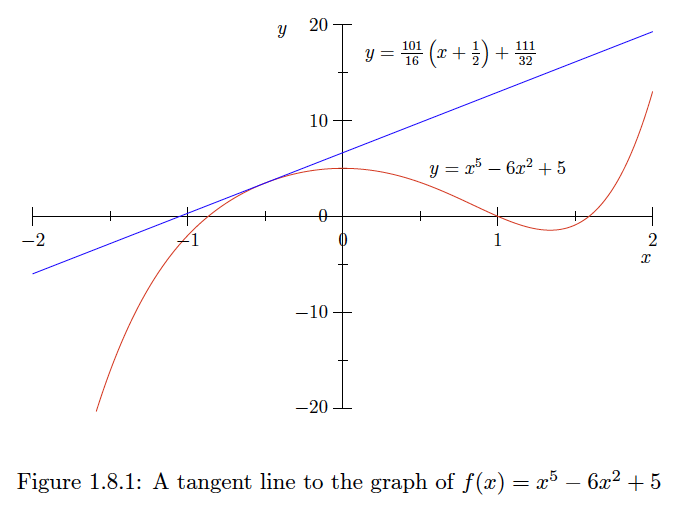1.8: A Geometric Interpretation of the Derivatives
- Page ID
- 25429
Recall that if \(y=f(x),\) then, for any real number \(\Delta x\),
\[\frac{\Delta y}{\Delta x}=\frac{f(x+\Delta x)-f(x)}{\Delta x}\] is the average rate of change of \(y\) with respect to \(x\) over the interval \([x, x+\Delta x]\) (see \((1.2 .7)) .\) Now if the graph of \(y\) is a straight line, that is, if \(f(x)=m x+b\) for some real numbers \(m\) and \(b,\) then \((1.8 .1)\) is \(m,\) the slope of the line. In fact, a straight line is characterized by the fact \((1.8 .1)\) is the same for any values of \(x\) and \(\Delta x .\) Moreover, \((1.8 .1)\) remains the same when \(\Delta x\) is infinitesimal; that is, the derivative of \(y\) with respect to \(x\) is the slope of the line. For other differentiable functions \(f,\) the value of \((1.8 .1)\) depends upon both \(x\) and \(\Delta x .\) However, for infinitesimal values of \(\Delta x,\) the shadow of \((1.8 .1),\) that is, the derivative \(\frac{d y}{d x},\) depends on \(x\) alone. Hence it is reasonable to think of \(\frac{d y}{d x}\) as the slope of the curve \(y=f(x)\) at a point \(x .\) Whereas the slope of a straight line is constant from point to point, for other differentiable functions the value of the slope of the curve will vary from point to point. If \(f\) is differentiable at a point \(a,\) we call the line with slope \(f^{\prime}(a)\) passing through \((a, f(a))\) the tangent line to the graph of \(f\) at \((a, f(a)) .\) That is, the tangent line to the graph of \(y=f(x)\) at \(x=a\) is the line with equation \[y=f^{\prime}(a)(x-a)+f(a) .\] Hence a tangent line to the graph of a function \(f\) is a line through a point on the graph of \(f\) whose slope is equal to the slope of the graph at that point.
Example \(\PageIndex{1}\)
If \(f(x)=x^{5}-6 x^{2}+5,\) then
\[f^{\prime}(x)=5 x^{4}-12 x .\] In particular, \(f^{\prime}\left(-\frac{1}{2}\right)=\frac{101}{16},\) and so the equation of the line tangent to the graph of \(f\) at \(x=-\frac{1}{2}\) is \[y=\frac{101}{6}\left(x+\frac{1}{2}\right)+\frac{111}{32} .\] See Figure 1.8.1
Exercise \(\PageIndex{1}\)
Find an equation for the line tangent to the graph of
\[f(x)=3 x^{4}-6 x+3\] at \(x=2\).- Answer
-
\(y=90(x-2)+39\)
Exercise \(\PageIndex{2}\)
Find an equation for the line tangent to the graph of
\[y=3 \sin ^{2}(x)\] at \(x=\frac{\pi}{4}\).- Answer
-
\(y=3\left(t-\frac{\pi}{4}\right)+\frac{3}{2}\)


